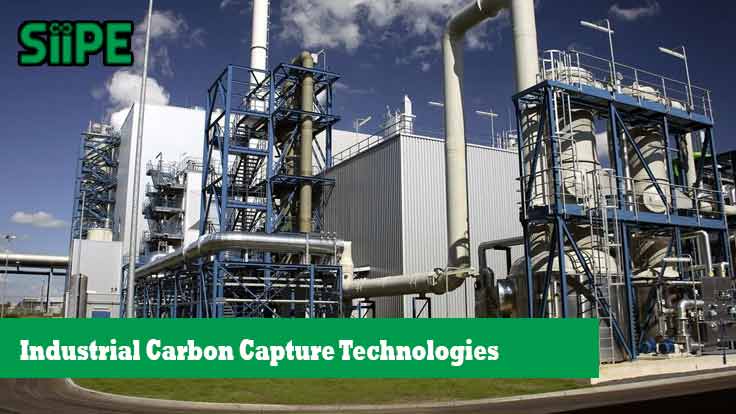The industrial sector is one of the largest contributors to greenhouse gas emissions globally. Heavy industries such as cement, steel, petrochemicals, and energy production emit vast amounts of carbon dioxide (CO₂) during their operations. In the fight against climate change, industrial carbon capture technologies have emerged as a key strategy to reduce emissions while allowing industries to continue operating efficiently.
This article explores what carbon capture is, the technologies involved, current applications, challenges, and its role in a sustainable future.
What Is Industrial Carbon Capture?
Carbon Capture and Storage (CCS) refers to the process of capturing CO₂ emissions from industrial sources before they reach the atmosphere. Once captured, the CO₂ is transported and stored underground in geological formations or reused in industrial processes.
There are three main stages of CCS:
-
Capture – Separating CO₂ from gases produced during industrial processes.
-
Transport – Moving the CO₂, usually via pipelines, to storage or usage sites.
-
Storage or Utilization – Injecting CO₂ into underground storage (such as depleted oil fields) or reusing it in products like concrete or synthetic fuels.
Why Carbon Capture Is Important for Industry
While renewable energy can reduce emissions in power generation, certain industries are “hard-to-abate.” These industries produce CO₂ not only from energy use but also from chemical reactions in their processes. For example:
-
Cement production emits CO₂ from limestone calcination.
-
Steelmaking uses coke that releases carbon.
-
Fertilizer plants release CO₂ as a byproduct of ammonia production.
Industrial carbon capture offers a solution that complements renewables and energy efficiency. It enables deep decarbonization of these sectors without complete system overhauls.
Major Carbon Capture Technologies
There are several technologies used to capture CO₂ in industrial settings:
1. Post-Combustion Capture
This is the most common method. It captures CO₂ from flue gases after fossil fuels are burned. Solvents such as amines absorb CO₂, which is then separated and compressed.
Used in: Power plants, cement factories, waste-to-energy facilities.
2. Pre-Combustion Capture
Involves removing CO₂ before combustion. Fossil fuels are gasified into a mixture of hydrogen and CO₂. The CO₂ is then separated, and the hydrogen is burned for energy.
Used in: Hydrogen production, synthetic fuel plants.
3. Oxy-Fuel Combustion
Fuels are burned in pure oxygen instead of air. This results in flue gas that is mostly CO₂ and water vapor, making it easier to isolate and store CO₂.
Used in: Experimental power plants and industrial pilots.
4. Direct Air Capture (DAC)
Although not tied to a specific industrial source, DAC technologies capture CO₂ directly from ambient air. They can offset emissions from industries that are difficult to decarbonize.
Real-World Industrial Applications
Several industrial sites around the world have implemented carbon capture:
-
Boundary Dam Power Station (Canada): One of the first large-scale CCS projects in a coal-fired power plant.
-
Norcem Cement Plant (Norway): Integrates post-combustion carbon capture.
-
Shell’s Quest Project (Canada): Captures and stores CO₂ from hydrogen production.
-
Carbon Clean (India & UK): Deploys modular carbon capture units for smaller industrial sites.
These examples show that CCS is not just theoretical—it’s being used today to cut industrial emissions.
Carbon Utilization: Turning Waste Into Value
Captured CO₂ doesn’t always need to be stored. In some cases, it can be reused:
-
Concrete curing: CO₂ is injected into concrete to strengthen it and trap the gas permanently.
-
Enhanced oil recovery (EOR): CO₂ is pumped into oil reservoirs to extract more oil while storing the gas.
-
Synthetic fuels: CO₂ can be combined with hydrogen to create low-carbon fuels.
-
Carbonated drinks and dry ice: Industrial CO₂ is used in the food and beverage sector.
Carbon utilization can turn an environmental burden into an economic opportunity.
Challenges of Industrial Carbon Capture
Despite its promise, CCS faces several challenges:
1. High Costs
Building and operating carbon capture equipment can be expensive. For many businesses, CCS is not yet economically viable without subsidies or carbon pricing.
2. Infrastructure Needs
Transporting CO₂ to storage sites requires pipelines or specialized vehicles, which are not widely available in all regions.
3. Energy Requirements
Capture processes, especially amine scrubbing, require a lot of energy—reducing the overall efficiency of the industrial plant.
4. Storage Risks and Regulations
Long-term underground storage must be secure to avoid leaks. Public acceptance and regulatory frameworks are still developing in many countries.
Policies Driving CCS Adoption
Governments around the world are recognizing the role of carbon capture in meeting climate targets. Examples of supportive policies include:
-
Tax credits in the U.S. (45Q policy).
-
EU Innovation Fund grants for CCS projects.
-
Carbon pricing schemes that reward low-carbon technologies.
-
Funding for research and development in cleaner industrial technologies.
The Role of Carbon Capture in a Net-Zero Future
To meet the Paris Agreement and national net-zero targets, industrial emissions must be drastically reduced. CCS plays a critical role in:
-
Decarbonizing hard-to-abate sectors.
-
Balancing emissions that can’t be avoided.
-
Creating negative emissions when combined with bioenergy (BECCS) or DAC.
The International Energy Agency (IEA) estimates that CCS could reduce global CO₂ emissions by nearly 15% by 2050.
Frequently Asked Questions (FAQ)
Q1: Is carbon capture safe?
Yes, when done correctly. CO₂ is stored deep underground in stable rock formations, similar to natural gas.
Q2: Does carbon capture encourage continued fossil fuel use?
Critics argue this, but CCS is mainly aimed at unavoidable emissions from industrial processes.
Q3: Can small businesses use carbon capture?
Yes. New modular and affordable technologies are emerging for smaller-scale applications.
Q4: What industries benefit most from CCS?
Cement, steel, ammonia, power generation, and chemical industries are primary beneficiaries.
Q5: How does carbon capture compare to planting trees?
Both are important. Trees absorb CO₂ gradually, while CCS captures large volumes quickly.
Industrial carbon capture technologies are an essential tool in the global effort to combat climate change. While challenges remain—especially around cost and infrastructure—the technology is rapidly advancing. With support from governments, industry, and innovators, CCS can help industries decarbonize without sacrificing productivity or competitiveness.
For countries with ambitious climate goals, industrial carbon capture isn’t just an option—it’s a necessity.











